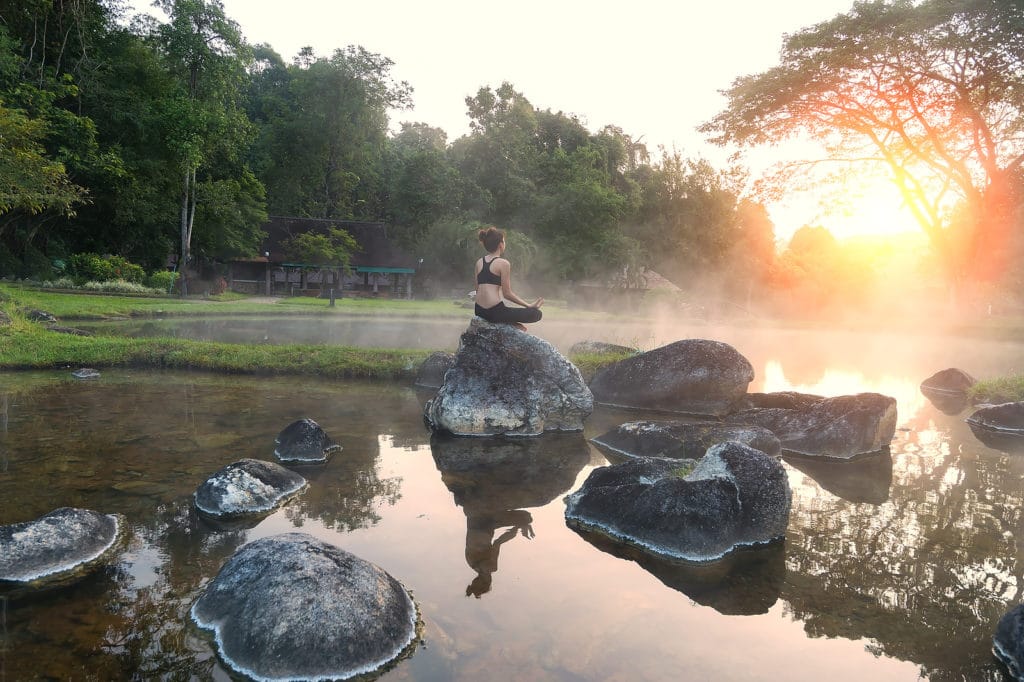Warning: Undefined array key 1 in /var/www/wp-content/plugins/monarch/monarch.php on line 4359
Does the word “meditation” conjure up images of gurus with flowing robes and long hair, lighting incense sticks while repeating “OM” over and over? If you were around in the 1960’s, you probably first learned of meditation as part of the Hippie counterculture.
Maharishi Mahesh Yogi is credited with bringing meditation to the West, teaching Transcendental Meditation (TM) to the Beatles and other consciousness-expanding musicians and celebrities. Because of this introduction, people who were adults in that era now perceive of meditation as something only for cult members and Buddhist Monks. Nothing could be further from the truth.
In 1979, Dr. Jon Kabat-Zinn was the first to demonstrate clinical proof of the benefits of meditation that scientists and doctors began to take seriously. He brought “mindfulness” into mainstream thinking through his Mindfulness-Based Stress Reduction (MBSR) course. At first, he worked primarily on pain management, and then expanded to treating depression, anxiety, and many other medical issues.
However, it wasn’t until the 1990’s that meditation started to receive acceptance in popular culture. Authors such as Eckhart Tolle and Deepak Chopra introduced a wider audience to the benefits of meditation, which are numerous. Meditation has been scientifically proven to help people release stress, along with a long list of other benefits. Specifically, stress causes an important hormone, klotho, to decline. Calming activities like meditation help keep stress under control, which promotes brain and body health.
Benefits of Meditation
In addition to stress reduction, regular meditation has been linked to a wide range of benefits. Meditation has been found to help people. Check out the benefits below:
- Slow the aging process
- Lower blood pressure
- Reduce chronic pain, depression, and anxiety
- Improve sleep quality
- Increase the ability to concentrate and focus
- Learn the capacity to calm oneself, and clear the mind
- Heighten positive emotions
- Enhance self-acceptance
- Boost creativity
- Gain perspective on life events
- Become less reactive
- Develop better cardiovascular health and immunity
- Alleviate gastrointestinal difficulties
- Foster a healthy lifestyle
Types of Meditation
There are many types or styles of meditation, of which TM (with its spiritual and religious connotations) is merely one. Here is a brief primer on a few of the various alternatives, and what they mean:
- TM – using a sound or mantra, one seeks to let the mind settle down and transcend thought. The goal is a state of enlightenment. This type of meditation usually requires a teacher or guide to become proficient.
- Mindfulness Meditation – while paying attention to one’s breathing, sensations, and thoughts, the goal is to “be” in the present moment. You should try to notice external sensations such as sounds, sights, and touch that make up your moment-to-moment experience.
- Guided Meditation (or Guided Visualization) – is a somewhat newer technique, designed for spiritual healing, stress relief, or personal development. A trained practitioner guides participants through the meditation process, having them generate mental imagery. The information gained from this technique can provide valuable insights into a person’s physical and mental condition, and form the basis of a treatment plan.
- Qi Gong – one of the oldest forms of meditation, it combines breathing techniques, movement, and meditation to improve posture, respiration, and the ability to relax.
- Heart Rhythm Meditation (HRM) – concentrates mainly on the heart, with an emphasis on breathing.
- So Hum Meditation – uses breathing and a simple mantra to quiet the mind. More on this in a moment, but for now you should know that despite its simplicity, it can be a very powerful experience.
How to Meditate with So Hum
So Hum meditation is a type of “mantra” meditation, using the words “So,” meaning “That,” and “Hum,” meaning “I,” literally translated as “I Am That,” or “I Am That I Am.” So Hum meditation emphasizes our connection to the universal energy, which supports and nourishes us in all that we do. Unlike TM, where mantras are personalized, So Hum uses the same universal mantra for everyone, which is tied to your breathing. Sooooo is the sound of inhalation and hummmmm is the sound of exhalation.
So Hum is one of the simplest forms of meditation practice, and it can be done in whatever time you have available, even if it’s only five minutes. The steps are straightforward and easy to follow:
- Find a place where you can sit undisturbed for a period of time. You don’t have to be alone, but you should not be interrupted. Also, turn off the TV and radio, and put your phone on silent running. Set a timer for your session, so you don’t feel the need to open your eyes and check the clock.
- Sit upright with your spine as straight as possible, and make yourself comfortable. There is absolutely no necessity to sit in a full lotus pose or twist your ankles into pretzels. A comfy chair is fine, as long as your back is straight.
- Relax your shoulders and arms. Some people touch their thumb and forefinger together, but that’s not necessary as long as you are relaxed. Try gently spreading your fingers out on your upper thigh.
- Close your eyes. Allow one full minute to take deep, cleansing breaths. Breathe from your diaphragm. You will know that you are doing this correctly if your belly goes in and out with each breath.
- While you are settling down, try to notice how you feel, both mentally and physically.
- Begin repeating the mantra, So Hum, silently to yourself.
a. Inhale as you silently repeat “Sooooo”
b. Exhale as you silently repeat “Hummmmm” - Find your own rhythm, being careful not to speed up. Some people like to listen to a recording, and follow along. This may be helpful in the beginning, but once you get the hang of it you shouldn’t need this guide. Relaxing music can be playing in the background, as long as it doesn’t distract you.
- If your mind begins to wander (and it will), gently bring it back to your silent mantra and your breath. You may have to do this over and over, particularly in the beginning. Don’t worry about it, it’s perfectly natural.
- When your timer goes off, stop repeating the mantra and just concentrate on your breathing. If you can, just sit quietly for another minute or two, and try to think about the expansive energy all around you.
At first, it may seem odd. You may or may not feel any benefits initially, but don’t give up. With consistent practice, you will see a range of physical, mental, emotional, and even spiritual benefits.
When to Meditate
There is no one single time that is best to meditate for everyone. That having been said, many people find mornings to be an ideal time, as it can set the tone for the rest of your day. Also, mornings tend to be quieter than other times of the day. If you live with other people, you can plan to get up a few minutes before everyone else and meditate before you get distracted and involved in other activities.
Another consideration is consistency. Whatever time you choose, you should try to develop the habit of meditating on a consistent basis in order to reap the full benefits. The good news is that you don’t have to leave the house or buy any special equipment or clothing. Just find a quiet location, a comfortable chair, and begin. It’s one of the easiest health resolutions to follow!
I’m a self-professed madman, adventurer, photographer, certified High-Performance Coach, martial artist, and licensed physical trainer specializing in senior fitness. My passion is to continue growing and developing into my own unique, gifted, and joyful authenticity, while committing myself towards doing my own special part to help change the world. My mission is to help others find their own direction and purpose in life, by means of mentoring, teaching, and empowering.








